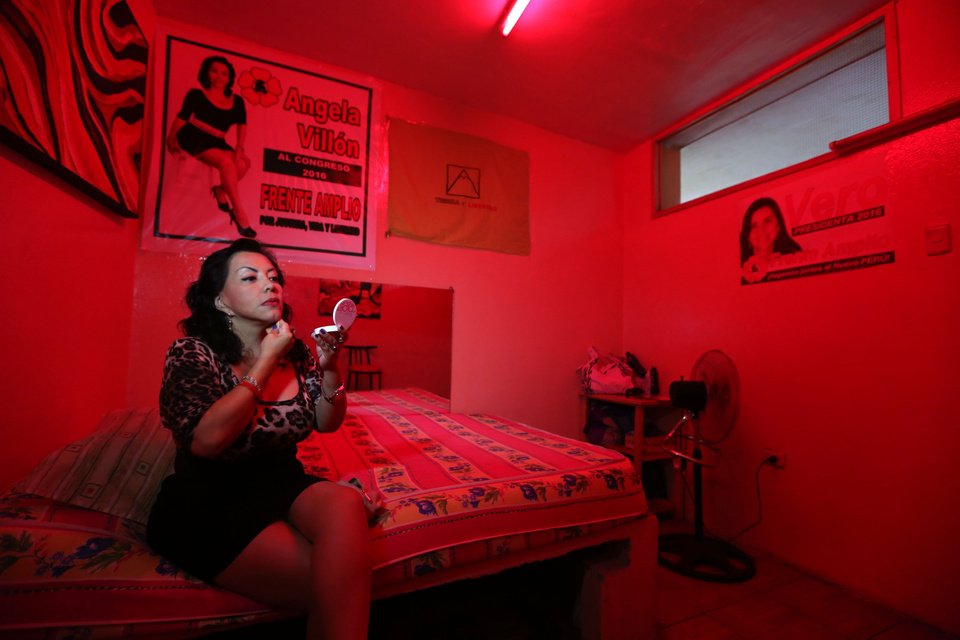(CRS) Despite being called the oldest profession in the world, little is known about how this unique market works. A recent study sheds light on the business of selling sex in the city of Chicago and finds that it is much like any other business.
Most crimes involve a victim and a perpetrator. The perpetrator typically looks for his victim and the victim avoids the perpetrator as much as he can. The crime of prostitution, however, is quite different.There are two parties involved but it isn’t clear who the perpetrator is and who the victim is. Moreover, it is in the interest of both the prostitute and the client to do their best to find one another. As a result, prostitution operates just like a market: it is populated by buyers and sellers who mutually benefit when they come together to perform a transaction.
Interesting questions emerge when one thinks of prostitution as a market, but there is surprisingly little research on the economics of this particular profession. How do prostitutes and their customers, or “johns,” find one another? How much do prostitutes charge for a service, or “trick,” and how is that price negotiated? If a john prefers not to use a condom, how much more does he have to pay? How does a prostitute’s wage compare to what she earns for doing other jobs? What happens when there’s a sudden surge in demand for prostitutes, and how do prostitutes meet this demand? The difficulty of obtaining reliable data is partly to blame for the dearth of empirical analysis on the subject.
In a recent study, “An Empirical Analysis of Street-Level Prostitution,” University of Chicago professor Steven D. Levitt and Sudhir Alladi Venkatesh of Columbia University uncover intriguing answers to these questions by using publicly available information from the Chicago Police Department and, more importantly, detailed and real-time transaction data for over 2,200 tricks performed by about 160 prostitutes in three Chicago neighborhoods that the authors collected with the help of pimps and prostitutes.
The bulk of this massive data undertaking was done by trackers who were hired to follow prostitutes for two years. The trackers are mostly former prostitutes. They stood on street corners and sat in brothels, recording valuable information on every trick performed immediately after a customer left. Embedding data trackers in the daily activities of prostitutes and collecting data in real time has the potential to generate more accurate information than standard survey methods. “The prostitutes know the data collectors, trust the data collectors, and hopefully will be honest with the data collectors,” Levitt says.
Location and Organization
Prostitutes want to be where their customers can easily find them, so they tend to cluster in areas well-known to their clients much like stores do in shopping malls. Traditional marketing channels, however, are not open to them. Thus, plying their trade along stretches of major roads is an easy way for customers to survey the market without appearing suspicious. Statistics on official arrests from the Chicago Police Department from August 19, 2005, to May 1, 2007, suggest that prostitution activity is highly concentrated. Nearly half of all prostitution arrests occur in a tiny one-third of one percent of all blocks in the entire city of Chicago.
Drug selling incidents–another market-based crime– likewise occur in far fewer blocks compared with other crimes such as assault, burglary, and theft. However, drug selling is not as concentrated as prostitution. Drug dealers have to be mobile because the law on illegal drugs is more heavily enforced. Moreover, a typical drug buyer will purchase drugs more frequently than a typical john will visit a prostitute. As a result, dealers tend to know their clients better and have other ways of communicating where they will be and how to make a transaction. Prostitutes, on the other hand, deal mostly with strangers.
Looking beyond official statistics, Levitt and Venkatesh gathered and analyzed their own data, beginning with the Roseland and Pullman neighborhoods on the far South Side of Chicago. Although these neighborhoods are adjacent to one another and share similar economic and demographic characteristics, prostitutes in Roseland work without pimps while all street prostitutes in Pullman work with one of four pimps in the area. After approximately 16 months, the authors decided to include the Washington Park neighborhood when a local police campaign drove prostitution in Roseland down by a third and two pimps in Pullman were forced to close shop. Some of the women who were part of the study moved their business to Washington Park.
Prostitutes who work for pimps appear to do better than those who do not, typically working fewer hours and performing fewer tricks but still earning more money. Levitt and Venkatesh found that clients pay about $16 more per trick for women working with pimps, although some of that extra revenue goes to the pimp in return for setting up clients and protecting them against abusive customers. But even after subtracting fees for these services, a prostitute managed by a pimp receives a much higher hourly wage than if she had to fend for herself. Comparing the earnings of a subset of Roseland and Pullman prostitutes, the authors estimated that women who work without pimps earn about $25 per hour while those working with pimps earn 50 percent more.
It isn’t clear why pimps would be willing to pay a rate that is above the minimum required, or what economists call an “efficiency wage.” One possible explanation is that it’s hard for pimps to always keep an eye on the women they manage. Pimps want repeat customers, so they have to make sure that the prostitutes are serving their clients the way the pimps would want them to. By paying more, pimps effectively raise the penalty associated with being fired, which will hopefully induce better behavior on the part of the prostitutes.
The Price of a Trick
The fee for a trick varies with the type of sex act, and prostitutes seem to discriminate across clients in order to maximize profit. White men pay $8 to $9 more per trick than black customers, with Hispanic clients paying some amount in between. When bargaining, prostitutes will usually offer a price to a black customer but will make a white man throw out a number first. Repeat customers pay slightly less than new customers.
The overall price of a trick goes up by $2 if a condom is not used. Although the price premium increases with the risk associated with a particular sex act, it is much smaller than the 24 percent premium that another study reports in a survey of Mexican prostitutes. One possible way to understand this disparity is to look at where the point of bargaining begins. Using a condom is the norm in Mexico, unless a client bargains away from it, which can potentially induce large price increases. In contrast, no condom is the default in Chicago unless the customer bargains toward it, which might make it harder for the prostitute to credibly argue for a higher price.
Still, a $2 premium may seem paltry considering the enormous risk that comes with unprotected sex, not to mention that condom use is shockingly low. Levitt and Venkatesh found that condoms are used in only one of every four tricks, making the risk of contracting a sexually transmitted infection very high. These women face other perils as well. Prostitutes report that they are violently assaulted about once every month. Compared with jobs outside of prostitution, such as a daycare or babysitting job, prostitutes earn far more at about $25 to $30 per hour, or, roughly four times what they would take home otherwise. But because prostitution is such a dangerous, unpleasant, and stigmatizing job, are these women really earning enough to compensate them for the risks they bear?
From an outsider’s perspective, an $18 per hour wage premium doesn’t seem like a very generous enticement to do such a seemingly rotten job. However, Levitt says that from the prostitutes’ point of view and given the menu of options they have, they must believe that it is a fair compensation because they have chosen this profession. Many of them will do other work as well and prostitution is just part of a portfolio of ways that women get by in these communities. “Prostitution doesn’t seem to be a stark moral choice,” says Levitt. “It’s like a job. When it pays better, women will quit other jobs to do it.”
For example, Levitt and Venkatesh found that during the Fourth of July holiday, demand for prostitution in the Washington Park neighborhood shot up because of a large number of people who came to join the festivities in the park. As a result, the price for a trick increased by about 30 percent. To absorb this rise in demand, regular neighborhood prostitutes worked more hours while prostitutes from outside provided additional tricks. But there were other recruits, too. Women who were typically not prostitutes were willing to supply tricks at the higher price that accompanied the holiday spike in demand.
Crime and Punishment
In contrast to selling illegal drugs, there doesn’t seem to be much public will to punish prostitutes and even less to punish the men who frequent the prostitutes. “I think society has decided that prostitution is not a very grave offense, and it is treated accordingly,” says Levitt.
As a result, the risk of incarceration is low. Combining data on police arrests from the Chicago Police Department and the results of the authors’ own survey, the study estimates that prostitutes are arrested only once in every 450 tricks, but only one in ten of these arrests will lead to a prison sentence. Johns are arrested even less frequently, with only one john arrested for every 1,200 tricks.
But perhaps more striking is the rate at which a police officer can extort free sex from a prostitute. Levitt and Venkatesh found that about one in 30 tricks performed by a prostitute is a freebie to the police in return for avoiding arrest. In other words, a prostitute is more likely to have sex with an on-duty police officer than to be arrested by one.
“That is a statement about prostitution, and at its heart, it’s a statement about how confusing and topsy-turvy life in the inner city is when the police who are there to enforce the law end up being some of the lawbreakers,” Levitt says. The knowledge gained from the study on how the inner city works may be useful in understanding which avenues are available when forming public policy. “If the police are busier having sex with prostitutes than arresting them, then it gives more realism about what one can and cannot expect when designing policies for the inner city,” says Levitt.




